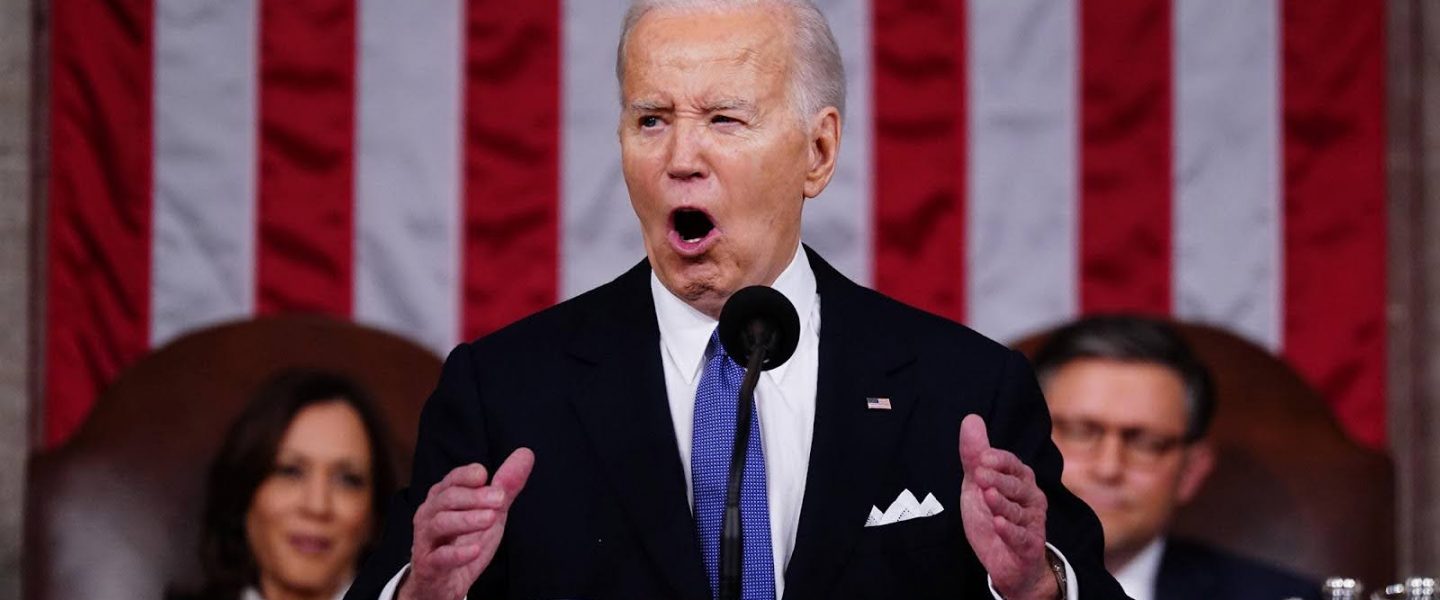The president briefly mentioned efforts to combat climate change and investments in science as he kicked off his run for a second term.
|
Listen To This Story
|
The presidential race is now essentially a Biden-Trump rematch, making President Joe Biden’s State of the Union address on Thursday an important campaign milestone.
In the speech, he reiterated efforts to slash emissions and promoted various science funding promises but focused mostly on other issues, such as the economy, immigration, and national security.
In Biden’s past annual addresses, issues related to climate, science, and education received relatively little airtime, replaced instead by comments on national and international crises, including threats to US democracy in 2021, the war in Ukraine in 2022, and the economy in 2023.
Though Biden delivered the second-longest speech of his term, he spent the least amount of time yet on climate and clean energy issues.
As in past years, Biden’s State of the Union covered a lot of ground, from climate change and clean energy to the economy to foreign policy. Credit: Grace van Deelen
Climate Commitments
Biden has two major climate policy wins under his belt, but he barely promoted them in the address: the 2022 Inflation Reduction Act and the 2021 Bipartisan Infrastructure Law. Both laws released billions of dollars in investments in clean energy and climate action, said Rachel Cleetus, policy director with the Climate and Energy program at the Union of Concerned Scientists.
In last year’s State of the Union, Biden stressed the importance of such investments, calling the climate crisis an “existential threat to our nation and to the world.” This year, he joked with Republicans in the audience, going off script to say he hoped they believed what the science shows about the reality of the climate crisis.
In another move celebrated by climate activists, Biden recently paused approvals for applications to export liquid natural gas, although he made no mention of this in last night’s address.
Next Steps
Biden’s legacy on climate, however, hasn’t been entirely about lowering emissions. Domestic oil production has climbed during his presidency. In his 2023 address, he indicated that a rapid reduction in fossil fuel use, which scientists say is necessary to keep warming under limits set by the Paris Agreement, wasn’t a priority, saying the world is “still going to need oil and gas for a while.”
Despite investments in clean energy, there “has not been nearly enough focus” during Biden’s term on policies that build communities’ resilience to current and future climate disasters, Cleetus said. One initiative she pointed to is the Justice40 Initiative, a federal goal to ensure that 40 percent of certain climate and clean energy funding benefits disadvantaged communities; this initiative has created “important, significant pots of money for communities that have long been marginalized,” Cleetus said.
Hearing what the next steps are for Biden’s clean energy and climate agenda is important, Cleetus said. But Biden didn’t mention what was next for his administration beyond doubling down on promises he’s already made, such as cutting the country’s carbon emissions in half by 2030 and installing hundreds of thousands of new electric vehicle charging stations. He called his administration’s efforts the “most significant action on climate ever in the history of the world.”
One initiative Biden advocated for in his address was the Climate Corps, a recently launched program meant to train young people for jobs in the clean energy sector, and he promised to triple the number of clean energy workers in the next decade.
Existing policies, however, aren’t enough to reach Biden’s climate goals, Cleetus said. To her, “we’ve run out of time for incremental progress. Now, we need transformational change.” Whoever the next president is, they will need to “fully recognize the scale of the challenge,” she said.
“We’ve run out of time for incremental progress. Now, we need transformational change.”
Many in the environmental movement will likely be upset by the lack of climate mentions in Biden’s speech, wrote Andrea Simonelli, a political scientist at Virginia Commonwealth University in Richmond, in an email. “The Inflation Reduction Act was a massive win for the environment, and not yelling about it from the rooftops was an opportunity lost,” she said.
The speech was delivered to boost Biden’s performance in November, Simonelli said, which she noted would be a win for climate action regardless of the lack of specifics in the address. “I cannot underscore enough the danger of a Trump presidency on the fate of the habitability of our planet,” Simonelli said.
Trump’s rhetoric on climate has been in stark contrast to Biden’s. In recent campaign speeches, Trump pledged to expand domestic oil and gas production, and his campaign has indicated that if elected, he would work to dismantle the Inflation Reduction Act. Such policy changes could lead to a spike in the nation’s carbon emissions; a recent analysis from Carbon Brief estimated that a Trump presidency could lead to an additional 4 billion metric tons of carbon dioxide or equivalent emissions by 2030.
Supporting Science
The president’s mentions of science funding and education policy were roughly similar to those in previous annual addresses. In past years, Biden signaled a commitment to science by promoting the Cancer Moonshot initiative and promising additional funding to the National Institutes of Health (NIH) for disease research.
In this year’s speech, he reiterated the importance of cancer research funding and ARPA-H (Advanced Research Projects Agency for Health), a new federal research agency supporting biomedical research, and announced additional science and education initiatives, including a $12 billion program to advance research into women’s health. “We can do big things like end cancer as we know it,” he said.
Biden’s enthusiasm for science funding comes as Congress is expected to approve a handful of spending bills that will slash budgets at some federal research agencies, including an $820 million cut to the National Science Foundation (NSF) and a $476 million cut to NASA’s planetary science program. The cuts to NSF will limit opportunities for scientists, especially graduate students and early-career scientists, said Matt Hourihan, associate director of research and development at the Federation of American Scientists, a policy research and advocacy organization.
“If we want to maintain US scientific leadership and competitiveness, and want to remain a hub for global talent, all of those things take investment in research.”
Biden briefly mentioned the CHIPS and Science Act, a 2022 law that set spending goals for federal research agencies, saying that the United States is “investing more in research and development than ever before.” But the figures set in the CHIPS and Science Act are targets, not appropriations, and fiscal year 2024 appropriations to date for research agencies are about $7.5 billion below those targets.
Now is a “great time for the president to make note of the importance of science and innovation for US prosperity, health, and competitiveness,” Hourihan said, given that the Biden administration is expected to propose a new federal budget next week. “The best way to indicate that his administration is prioritizing science and innovation is to propose a budget that does so,” Hourihan wrote in an email.
“If we want to maintain US scientific leadership and competitiveness, and want to remain a hub for global talent, all of those things take investment in research,” he said.
This story by Grace van Deelen was originally published by Eos Magazine and is part of Covering Climate Now, a global journalism collaboration strengthening coverage of the climate story.





